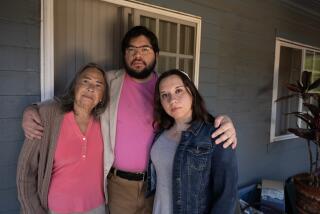The Bottom Lines : Senior Citizen With a Pseudonym Keeps Pasadena College’s Flea Market Hopping
- Share via
When the latest Flea Market was held at Pasadena City College last weekend, Felicia Flea hopped right to it, as usual.
So did the more than 6,000 other people--buying, selling, trading, browsing and eating.
Felicia Flea is the name Mary Alice Fox appropriated when it became clear that the PCC Flea Market was here to stay. The name just flowed out of her pen one day when she was signing receipts for vendors who were eagerly plunking down their monthly fees.
Fox was hired in 1979, when she was a 69-year-old re-entry student, to help transform the rummage sales that students were holding in a parking lot into a regularly scheduled flea market. Her job was a work-study project, which paid her while she got academic credit. Today, at the age of 75, Fox still does office work and public relations for the market.
Felicia Flea--the name just flowed out of her pen one day when she was signing receipts for vendors. From the very beginning, it looked as if Fox and the market were meant for each other. It started in 1977 with fund-raising rummage sales that grew to be frequent, and then regular, attractions. By 1979, someone was needed to bring order to a phenomenon that had no precedent.
The Pasadena sale was the first college-based flea market in Southern California. It was designed from the start to benefit student activities and has financed scholarships and major improvements to the school’s Student Activities Center.
The sale has always been on the first Sunday of every month in the college parking lot along Hill Avenue. It has always been wide open, so the public can park free and wander in from any direction with no admission charge. Its income is derived from $25-per-space fees that vendors pay.
At the first Flea Market in September, 1979, Fox asked the few vendors to spread out in order to make it look like something was happening. Student Activities grossed $900. Last Sunday, as usual in the past few years, there was a waiting list of vendors for the more than 300 spaces that reach from Colorado Boulevard to Del Mar Boulevard and spill over into alleyways.
Now the college grosses about $7,500 with each sale and has a net annual income of $24,000 after paying for a few employes, custodial and security services and advertising. Sometimes additional markets are scheduled to accommodate those on the waiting list or to raise funds for special needs. The money is administered by a board of directors.
For flea market habitues, there is something distinctive about the PCC sale that attracts repeat customers as well as vendors, Fox claims. The spaces are large, the aisles are wide, bargaining is low key, and very little hawking is heard. While vendors sell the same variety of merchandise found in other swap meets--including plants, clothes, records and tapes, leather goods and electronic gadgets--the PCC sale offers an unusual abundance of booths selling antiques, nostalgia and collectible items.
Only student and community organizations are allowed to operate the snack booths. Music from speakers is subdued, the pace is slow, entire families stroll, and there is an air of familiarity--even convivality.
Alvar Kauti, dean of Pasadena City College student activities, said the market has become something of a model for other colleges, which have experienced varying degrees of success in their efforts, and sometimes failure. Some community colleges in Orange and San Diego counties have ongoing flea markets, based on the plan PCC created.
Kauti calls his “the largest flea market this side of the Rose Bowl,” where another gigantic monthly flea market has about 1,200 vendors.
Fox sees it a little differently.
“Right from the beginning I said we’re not going to be looked down on by people who go to the Rose Bowl. But I just never dreamed it would be like this. Who could have dreamed this?”
More to Read
Sign up for Essential California
The most important California stories and recommendations in your inbox every morning.
You may occasionally receive promotional content from the Los Angeles Times.













